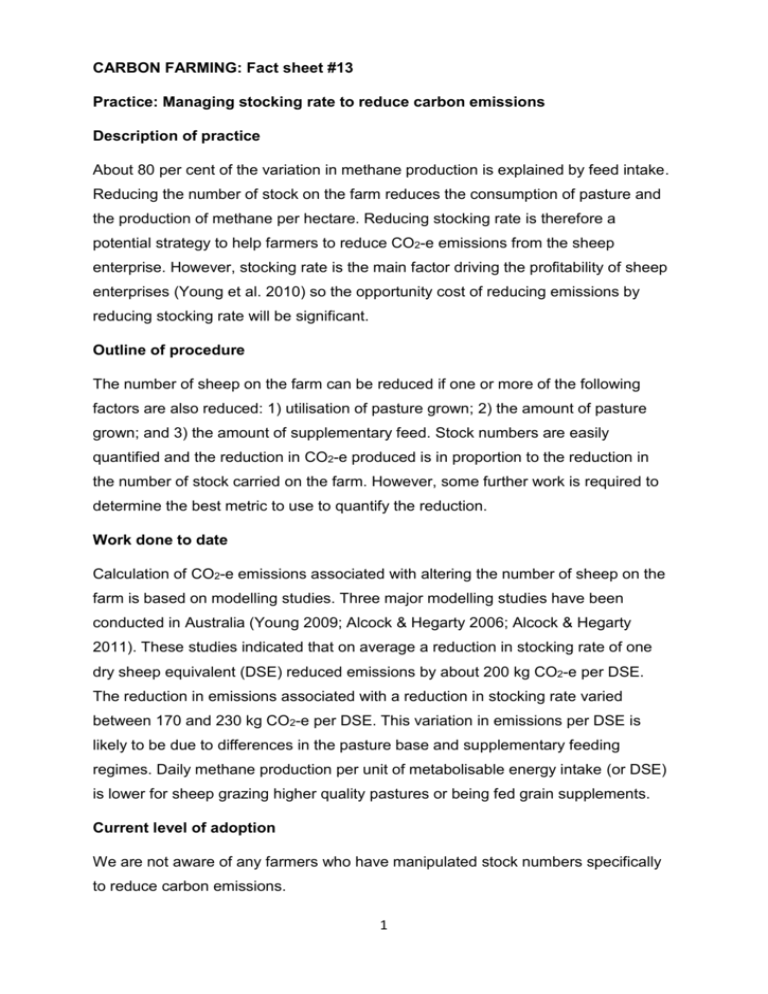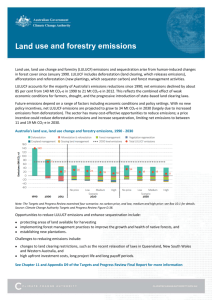Benefits - Department of Agriculture and Food
advertisement

CARBON FARMING: Fact sheet #13 Practice: Managing stocking rate to reduce carbon emissions Description of practice About 80 per cent of the variation in methane production is explained by feed intake. Reducing the number of stock on the farm reduces the consumption of pasture and the production of methane per hectare. Reducing stocking rate is therefore a potential strategy to help farmers to reduce CO2-e emissions from the sheep enterprise. However, stocking rate is the main factor driving the profitability of sheep enterprises (Young et al. 2010) so the opportunity cost of reducing emissions by reducing stocking rate will be significant. Outline of procedure The number of sheep on the farm can be reduced if one or more of the following factors are also reduced: 1) utilisation of pasture grown; 2) the amount of pasture grown; and 3) the amount of supplementary feed. Stock numbers are easily quantified and the reduction in CO2-e produced is in proportion to the reduction in the number of stock carried on the farm. However, some further work is required to determine the best metric to use to quantify the reduction. Work done to date Calculation of CO2-e emissions associated with altering the number of sheep on the farm is based on modelling studies. Three major modelling studies have been conducted in Australia (Young 2009; Alcock & Hegarty 2006; Alcock & Hegarty 2011). These studies indicated that on average a reduction in stocking rate of one dry sheep equivalent (DSE) reduced emissions by about 200 kg CO2-e per DSE. The reduction in emissions associated with a reduction in stocking rate varied between 170 and 230 kg CO2-e per DSE. This variation in emissions per DSE is likely to be due to differences in the pasture base and supplementary feeding regimes. Daily methane production per unit of metabolisable energy intake (or DSE) is lower for sheep grazing higher quality pastures or being fed grain supplements. Current level of adoption We are not aware of any farmers who have manipulated stock numbers specifically to reduce carbon emissions. 1 Industry activity None at this stage. The modelling analyses indicate that specialist sheep producers will be financially disadvantaged if they reduce stock numbers in order to reduce carbon emissions. The loss in profit is much greater than the potential compensation through the Emissions Reduction Fund (ERF). Benefits Commercial potential: Alcock and Hegarty (2006), Alcock and Hegarty (2011) and Young (2009) have all shown that production of CO2-e is proportional to the number of stock carried Co-benefits Recovery of degraded paddocks through reduced grazing pressure. Opportunities Reducing stocking rate to reduce CO2-e emissions is relevant to all sheep enterprises in Western Australia—including purebred merino, merino crosses and composite breeds. The opportunity, however, will only be for farms in need of recovery from degradation through reduced stocking density. For mixed farming enterprises in some regions, the drop in profit (caused by reducing sheep numbers) could be less or eliminated if the land previously used for grazing sheep were to be used for cropping or other more profitable enterprises not involving livestock. Risks Reducing stock numbers lowers profitability more than the current value of the saved carbon emissions. A 1 DSE reduction in stocking rate will currently lead to about a $30 reduction in profit, compared to the lower potential ERF payment. Similarly, Alcock and Hegarty (2006) reported that the stocking rate and also methane production from a farm based on unimproved pastures was about 40 per cent of that for a farm based on improved pastures, but the gross margin of the less productive farm was only 25 per cent of the more productive farm ($139/ha v. $525/ha). 2 Case study The typical sheep farm in Western Australia runs 1220 ewes, 560 lambs and 170 wethers and rams. This equates to about 2700 DSE. This farm would emit about 550 tonnes CO2-e per annum. Reducing stocking rate by 10 per cent would reduce emissions by 55 tonnes and the carbon credits from adopting this practice is likely to be less than the associated reduction in livestock profit of around $8100. Key contacts – Australia To our knowledge, no research groups in Australia are quantifying actual CO2-e emissions in relation to the stocking rate of sheep, with the possible exception of the Evergraze site in Hamilton, Victoria, in conjunction with Wollongong University (see link under Evergraze in key references). Dr Ralph Behrendt (Department of Primary Industries, Hamilton, Victoria) Dr Frances Phillips (University of Wollongong, NSW) Most work relating to CO2-e emissions and stocking rate is undertaken by farm systems modelling. Dr Andrew Moore (CSIRO, Canberra) John Young (Farming Systems Analysis Service, Kojonup, Western Australia) Doug Alcock (NSW DPI, Cooma) Brendan Cullen (University of Melbourne, Victoria) International work The main international group undertaking work related to stocking rates (and other management practices) on CO2-e emissions from sheep production systems is the New Zealand Agricultural Greenhouse Gas Research Centre, AgResearch. There is significant collaboration already occurring between this organisation and research institutes in Australia, including Western Australia. Several researchers in DAFWA are also members of the Livestock Emissions and Abatement Research Network (LEARN), which facilitates the development of practical and cost- effective mitigation strategies for agricultural greenhouse gases. 3 Stakeholders Farmers State government agencies and research institutions including DAFWA, Murdoch University, the University of Western Australia and CSIRO Rural Industry Research Corporations: Australian Wool Innovation and Meat & Livestock Australia Department of Agriculture, Fisheries and Forestry (DAFF) Next steps Major research, development and extension activities related to the effects of stocking rate and other management strategies for methane emissions are planned under the DAFF Filling the Research Gap – Modelling Research (see the link under key references). The two most relevant projects are: evaluating opportunities for sheep–wheat farmers to participate in the ERF (CSIRO, Rockhampton) researching greenhouse gas abatement options for whole farm grazing systems in southern Australian (University of Melbourne). Key references Alcock, DJ & Hegarty, RS 2006, ‘Effects of pasture improvement on productivity, gross margin and methane emissions of a grazing sheep enterprise’, International Congress Series, vol. 1293, pp. 103–106. Alcock, DJ & Hegarty, RS 2011, ‘Potential effects of animal management and genetic improvement on enteric methane emissions, emissions intensity and productivity of sheep enterprises at Cowra, Australia’, Animal Feed Science and Technology, vol. 166–167, pp. 749–760. Department of Agriculture, Fisheries and Forestry, Filling the Research Gap modelling research, www.daff.gov.au/climatechange/carbonfarmingfutures/ftrg/modelling-research-themeprojects 4 Evergraze, http://www.evergraze.com.au/ Livestock Emissions and Abatement Research Project (LEARN), www.livestockemissions.net/ Young, JM 2009, Implications of managing the greenhouse gas emissions from the livestock enterprise, unpublished report commissioned by the Sheep CRC. Young, JM, Thompson, AN & Kennedy 2010, ‘Bioeconomic modelling to identify the relative importance of a range of critical control points for prime lamb production systems in south-west Victoria’, Animal Production Science, vol. 50, pp. 748–756. New Zealand Agricultural Greenhouse Gas Research Centre (NZAGR), www.nzagrc.org.nz/integrated-systems.html 5






